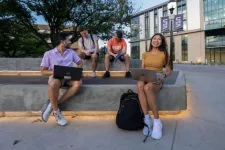(Press-News.org) Years ago, as she sat in waiting rooms, Maytal Saar-Tsechansky began to wonder how people chose a good doctor when they had no way of knowing a doctor’s track record on accurate diagnoses. Talking to other patients, she found they sometimes based choices on a physician’s personality or even the quality of their office furniture.
“I realized all these signals people are using are just not the right ones,” says Saar-Tsechansky, professor of information, risk, and operations management at Texas McCombs. “We were operating in complete darkness, like there’s no transparency on these things.”
In new research, she uses artificial intelligence to judge the judges: to evaluate the rates at which experts make successful decisions. Her machine learning algorithm can appraise both doctors and other kinds of experts — such as engineers who diagnose mechanical problems — when their success rates are not publicly available or not scrutinized beyond small groups of peers.
Prior research has studied how accurate doctors’ diagnoses are, but not in ways that can be scaled up or monitored on an ongoing basis, Saar-Tsechansky says.
More effective methods are vital today, she adds, when medical systems are deploying AI to help with diagnoses. It will be difficult to determine whether AI is helping or hurting successful diagnoses if observers can’t tell how successful a doctor was without the AI assist.
Evaluating the Experts
With McCombs doctoral student Wanxue Dong and Tomer Geva of Tel Aviv University in Israel, Saar-Tsechansky created an algorithm they call MDE-HYB. It integrates two forms of information: overall data about the quality of an expert’s past decisions and more detailed evaluations of specific cases.
They then compared MDE-HYB’s results with other kinds of evaluators: three alternative algorithms and 40 human reviewers. To test the flexibility of MDE-HYB’s ratings, three very different kinds of data were analyzed: sales tax audits, spam, and online movie reviews on IMDb.
In each case, evaluators judged prior decisions made by experts about the data: such as whether they accurately classified movie reviews as positive or negative. For all three sets, MDE-HYB equaled or bested all challengers.
Against other algorithms, its error rates were up to 95% lower.
Against humans, they were up to 72% lower.
The researchers also tested MDE-HYB on Saar-Tsechansky’s original concern: selecting a doctor based on the doctor’s history of correct diagnoses. Compared with doctors chosen by another algorithm, MDE-HYB dropped the average misdiagnosis rate by 41%.
In real-world use, such a difference could translate to better patient outcomes and lower costs, she says.
She cautions that MDE-HYB needs more work before putting it to such practical uses. “The main purpose of this paper was to get this idea out there, to get people to think about it, and hopefully people will improve this method,” she says.
But she hopes it can one day help managers and regulators monitor expert workers’ accuracy and decide when to intervene, if improvement is needed. Also, it might help consumers choose service providers such as doctors.
“In every profession where people make these types of decisions, it would be valuable to assess the quality of decision-making,” Saar-Tsechansky says. “I don’t think that any of us should be off the hook, especially if we make consequential decisions.”
“A Machine Learning Framework for Assessing Experts’ Decision Quality” is published in Management Science.
END
Picking the right doctor? AI could help
A machine learning algorithm can evaluate whether doctors, engineers, and other experts are making good decisions
2025-01-13
ELSE PRESS RELEASES FROM THIS DATE:
Travel distance to nearest lung cancer facility differs by racial and ethnic makeup of communities
2025-01-13
Embargoed for release until 5:00 p.m. ET on Monday 13 January 2025
@Annalsofim
Below please find summaries of new articles that will be published in the next issue of Annals of Internal Medicine. The summaries are not intended to substitute for the full articles as a source of information. This information is under strict embargo and by taking it into possession, media representatives are committing to the terms of the embargo not only on their own behalf, but also on behalf ...
UTA’s student success strategy earns national acclaim
2025-01-13
The University of Texas at Arlington has been recognized nationally for its commitment to student success and economic mobility, being named a winner in the inaugural Postsecondary Success Recognition Program (PSRP), a U.S. Department of Education initiative. This program honors institutions that excel in enrolling underserved student populations, supporting successful student transfers and completions and preparing graduates for careers that promote economic mobility.
UTA was one of only three bachelor’s degree–granting institutions across the nation ...
Wind turbines impair the access of bats to water bodies in agricultural landscapes
2025-01-13
Bats depend on open bodies of water such as small ponds and lakes for foraging and drinking. Access to water is particularly important for survival in the increasingly hot and dry summers caused by climate change, the time when female bats are pregnant and rear their young. A scientific team from the Leibniz Institute for Zoo and Wildlife Research (Leibniz-IZW) has now shown that access to drinking sites is hampered by wind turbines in agricultural landscapes: Many bat species avoid the turbines and water bodies ...
UCF biology researchers win awards from NOAA to support critical coastal work
2025-01-13
Biology researchers in the College of Sciences and UCF Coastal have received two awards from the National Oceanic and Atmospheric Administration (NOAA) totaling more than $2.3 million.
A new $1.1 million award to UCF from NOAA Sea Grant as part of the Marine Debris Challenge Competition will fund joint research between UCF’s CEELAB and Aquatic Biogeochemistry Laboratory’s research on plastic-free restored habitats in coastal shorelines and oyster reefs. UCF’s work, in partnership with Texas A&M, and University of Texas Marine Science Institute was selected as one of 11 projects ...
Geochemist Kevin Rosso appointed a Battelle Fellow
2025-01-13
RICHLAND, Wash.— Geochemist Kevin Rosso, a senior scientific leader at the Department of Energy’s Pacific Northwest National Laboratory, has been named a Battelle Fellow, the highest recognition at PNNL for leadership and accomplishment in science. He joins six other current Battelle Fellows at PNNL in an honor that less than 0.5% of PNNL scientists achieve during their careers.
Rosso is internationally known for his fundamental research on how energy flows among minerals, solutions and microorganisms. These complex processes center on the key role that interfaces—which are shared boundaries—play in controlling ...
NIH-funded study finds cases of ME/CFS increase following SARS-CoV-2
2025-01-13
What: New findings from the National Institutes of Health’s (NIH) Researching COVID to Enhance Recovery (RECOVER) Initiative suggest that infection with SARS-CoV-2, the virus that causes COVID-19, may be associated with an increase in the number of myalgic encephalomyelitis/chronic fatigue syndrome (ME/CFS) cases. According to the results, 4.5% post-COVID-19 participants met ME/CFS diagnostic criteria, compared to 0.6% participants that had not been infected by SARS-CoV-2 virus. RECOVER is NIH’s national program to understand, diagnose, prevent, and treat Long COVID.
The research team, led by Suzanne D. Vernon, Ph.D., from the Bateman Horne Center in Salt Lake City, ...
Biophotovoltaics: A step forward in sustainable energy technology
2025-01-13
In a groundbreaking study published in Environmental Science and Ecotechnology, researchers have advanced our understanding of biophotovoltaic (BPV) systems—innovative devices that merge photosynthetic microbes with electrochemical systems to convert sunlight into electricity. Using the cyanobacterium Synechocystis sp. PCC 6803, the study provides critical insights into the molecular mechanisms driving this green energy technology.
Central to BPV systems is the process of extracellular electron transfer (EET), where electrons generated during photosynthesis are harvested by an electrode via mediators such as ferricyanide. The research reveals that EET ...
Experimental blood test for pancreatic cancer undergoing clinical development and evaluation
2025-01-13
GRAND RAPIDS, Mich. (Jan. 13, 2025) — An experimental blood test for pancreatic cancer that was developed by Van Andel Institute and University of Pittsburgh scientists is being evaluated by a commercial laboratory, an important milestone toward making the test available for patients.
A recent double-blinded, peer-reviewed analysis published in Cancer Letters revealed that the experimental test correctly identified 71% of pancreatic cancer samples in the lab compared to only 44% correctly identified by the current gold-standard test. Teams led by ...
Polygamy is (not) for the birds
2025-01-13
Researchers at Rice University have uncovered new insights into the evolution of bird behavior, revealing why certain mating systems persist while others disappear over time. In a recent paper published in the journal Evolution, Rafael S. Marcondes and Nicolette Douvas reveal that lekking — a mating system where males display for females without forming lasting bonds — is an evolutionarily stable strategy. In contrast, resource-defense polygamy, where one sex — usually but ...
Hubble reveals surprising spiral shape of galaxy hosting young jet
2025-01-13
The night sky has always played a crucial role in navigation, from early ocean crossings to modern GPS. Besides stars, the United States Navy uses quasars as beacons. Quasars are distant galaxies with supermassive black holes, surrounded by brilliantly hot disks of swirling gas that can blast off jets of material. Following up on the groundbreaking 2020 discovery of newborn jets in a number of quasars, aspiring naval officer Olivia Achenbach of the United States Naval Academy has used NASA’s Hubble Space Telescope to reveal surprising properties of one of them, quasar J0742+2704.
"The biggest surprise was seeing the distinct ...
LAST 30 PRESS RELEASES:
Scientists use ultrasound to soften and treat cancer tumors without damaging healthy tissue
Community swimming program for Black youth boosts skills, sense of belonging, study finds
Specific depressive symptoms in midlife linked to increased dementia risk
An ‘illuminating’ design sheds light on cholesterol
Who is more likely to get long COVID?
Study showcases resilience and rapid growth of “living rocks”
Naval Research Lab diver earns Office of Naval Research 2025 Sailor of the Year
New Mayo-led study establishes practical definition for rapidly progressive dementia
Fossil fuel industry’s “climate false solutions” reinforce its power and aggravate environmental injustice
Researchers reveal bias in a widely used measure of algorithm performance
Alcohol causes cancer. A study from IOCB Prague confirms damage to DNA and shows how cells defend against it
Hidden viruses in wastewater treatment may shape public health risks, study finds
Unlock the power of nature: how biomass can transform climate mitigation
Biochar reshapes hidden soil microbes that capture carbon dioxide in farmland
Reducing saturated fat intake shows mortality benefit, but only in high-risk individuals
Manta rays create mobile ecosystems, study finds
Study: Mixed results in using lipoic acid to treat progressive multiple sclerosis
Norbert Holtkamp appointed director of Fermi National Accelerator Laboratory
New agentic AI platform accelerates advanced optics design
Biologists discover neurons use physical signals — not electricity — to stabilize communication
Researchers discover that a hormone can access the brain by hitchhiking
University of Oklahoma researcher awarded funding to pursue AI-powered material design
Exploring how the visual system recovers following injury
Support for parents with infants at pediatric check-ups leads to better reading and math skills in elementary school
Kids’ behavioral health is a growing share of family health costs
Day & night: Cancer disrupts the brain’s natural rhythm
COVID-19 vaccination significantly reduces risk to pregnant women and baby
The role of vaccination in maternal and perinatal outcomes associated with COVID-19 in pregnancy
Mayo Clinic smartwatch system helps parents shorten and defuse children's severe tantrums early
Behavioral health spending spikes to 40% of all children’s health expenditures, nearly doubling in a decade
[Press-News.org] Picking the right doctor? AI could helpA machine learning algorithm can evaluate whether doctors, engineers, and other experts are making good decisions





